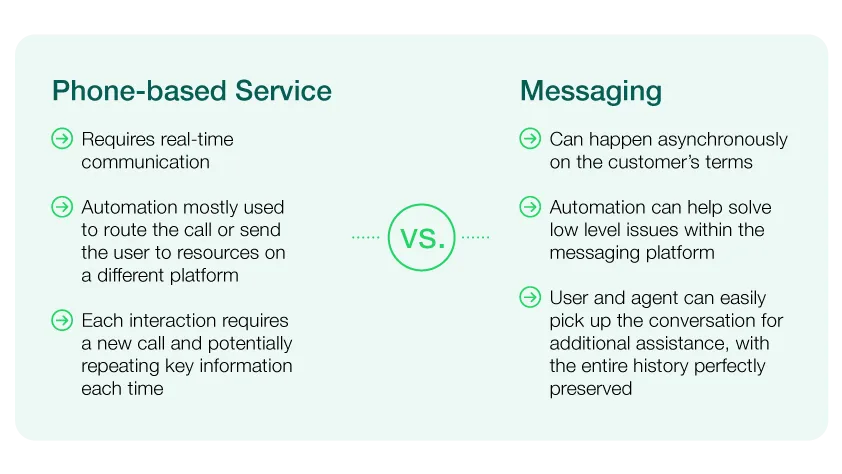Customers
The Future of Support – Beyond Call Centers and Native Apps
|
July 5, 2022
Customers
|
July 5, 2022

The anxiety of needing to call customer service is nothing new. Long wait times. Confusing IVR experiences. Frustrating conversations with live agents who don’t seem to be listening. And now you can pair all of this with a generational aversion to phone calls. All of which means that, despite ongoing technological and process improvements, phone calls are often seen as an option of last resort for contacting a business.
As a result of these shifts, forward-thinking businesses have adapted.
Call centers have evolved into multi-channel contact centers. Support teams have dedicated, easy-to-find email addresses. AI-powered chat functionality now pops up when visiting websites. Support options have been baked into many companies’ native mobile apps. And while these solutions have garnered success, businesses are realizing they come with their own share of problems – both social and functional.
Case in point: email is quickly being added to the “no thank you” list alongside phone calls – especially among Gen Z. Live chat on a website requires a customer to stay active and engaged on the site. When that’s not possible, many customers fall back on email or phone calls to finish their support interaction. And while native apps often don’t share these roadblocks, trends show that most users are unlikely to regularly engage with native apps. In fact, most device users only interact with 10 apps a day and 25% of apps downloaded aren’t used after the initial opening.1
Fortunately, advancements in messaging technology are creating entirely new possibilities for businesses wanting to engage with customers across the buyer journey. Messaging apps are consistently among the most downloaded and used apps.2 And they’re increasingly becoming a channel of choice for consumers that wish to connect with businesses. In fact, a 2020 survey found that 75% of respondents prefer connecting to businesses through messaging apps.3 Add in business-centric features, like automation and APIs that easily integrate with support tech stacks, and companies can use these tools at scale to meet customers right where they are.
But how does a messaging-based customer service experience stack up? Let’s take a look.

Modern messaging and traditional phone-based service are two entirely different experiences. Messaging is a form of asynchronous communication – allowing the conversation to happen on the customer’s timetable. If an agent isn’t available – or a customer can’t respond right away – there’s no calling back and waiting again, the convo just picks right back up. Phone-based service is real-time, synchronous conversation – leaving customers stuck on hold until someone can help them.
In addition to helping reduce wait times, messaging keeps a full history of the entire interaction. This helps reduce the number of times a customer has to repeat themselves, a common frustration with phone support.
Documentation and media is another place messaging shines. On the phone, agents and customers have to rely on additional systems – email or web-based – to make the exchange. On the other hand, a rich messaging experience means they can send photos, videos, documents, locations, or more right in the conversation. This reduces the possibility of dropping out while bouncing back and forth between apps and helps get to a solution faster.
Finally, using automated messaging, businesses can often handle low-complexity issues with a self-serve model, reserving your customer service agents for complex problem solving that requires a human touch.
While email, on-site chat, and native apps all help address some of the issues with phone calls – they each have their own drawbacks. Some of these are social – meaning users are less likely to adopt them or they deliver a subpar experience. Other shortcomings are technical – either still requiring real-time agent interactions or not being able to resolve concerns without moving to another platform. Messaging can help overcome both of these types of obstacles.
Messaging provides faster and clearer communication than email. It eliminates the need for customers and support agents to visit an overwhelming inbox or keep track of complex threaded replies. And given that a 2021 survey found that 62% of companies don’t answer support emails – messaging helps keep your customers from being ignored. Messaging empowers your customers to reach out when they want, on a platform they’re comfortable with, helping increase the likelihood of user adoption. They no longer have to keep a chat window open in their browser or your native app. And given the ongoing sense of app fatigue, messaging helps connect with customers who wouldn’t download a new app.
Does this mean we’re going to start seeing contact centers disappear or native apps taken off the app stores? We don’t think that’s likely. There’s too many good reasons to maintain smart, well-trained support teams and the unique experience that a native app can deliver. Luckily, modern messaging platforms like WhatsApp, Messenger, and Instagram Direct offer business solutions that can complement your existing tools. From “click-to” functionality that lets you move from your site, app, or ad directly to a conversation all the way to APIs that can integrate with your backend systems. Creating a robust, rich conversational experience is available in a size and scope that can fit your needs.
In fact, many businesses have already begun using messaging solutions. A study by McKinsey found that 77% of organizations surveyed have digital platforms already built. Unfortunately it also found that only 12% have highly integrated those systems.4 The difference between just adding new functionality and transforming your customer experience relies on tight integration. Dive deeper into how integrating WhatsApp Business Platform can transform your service offerings with the resources below: